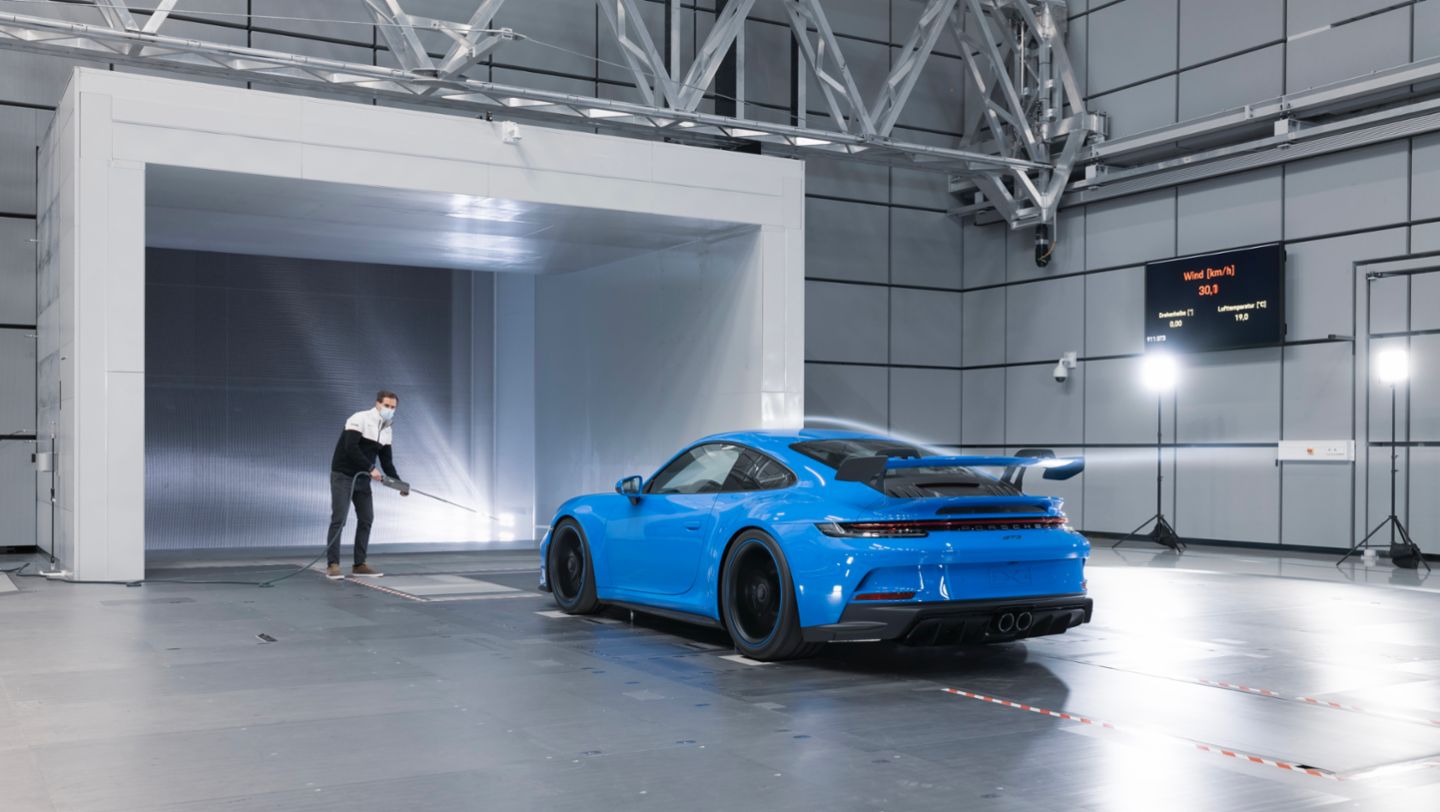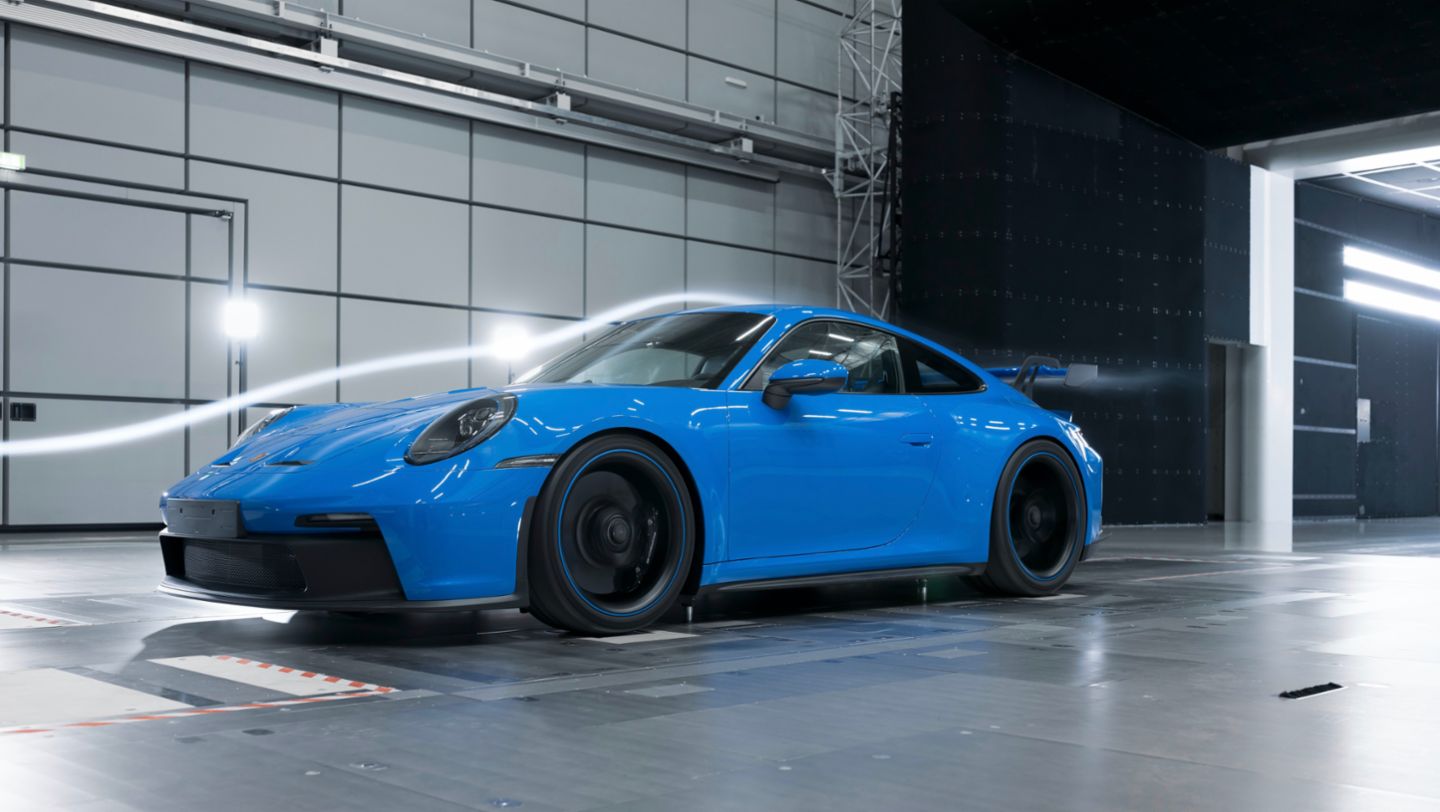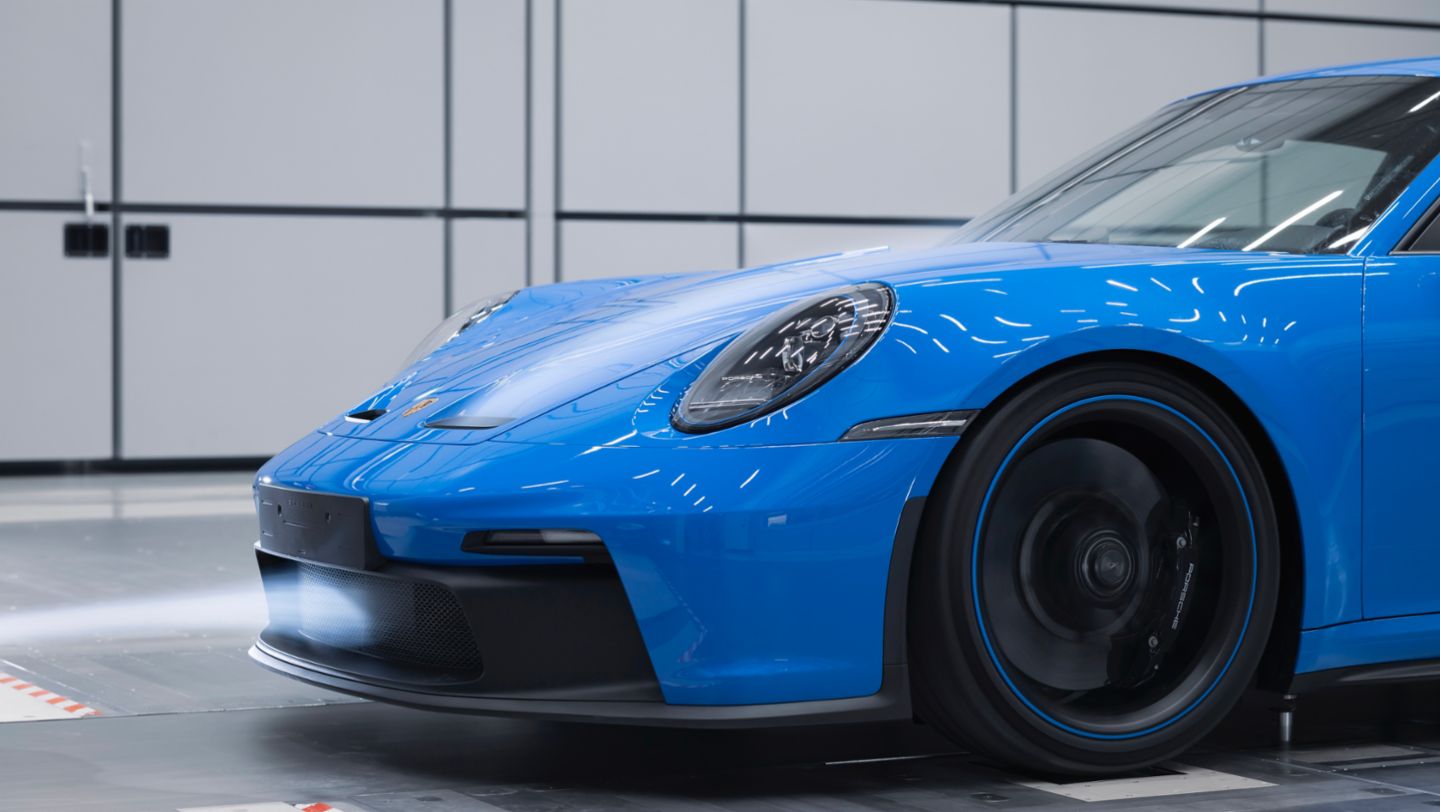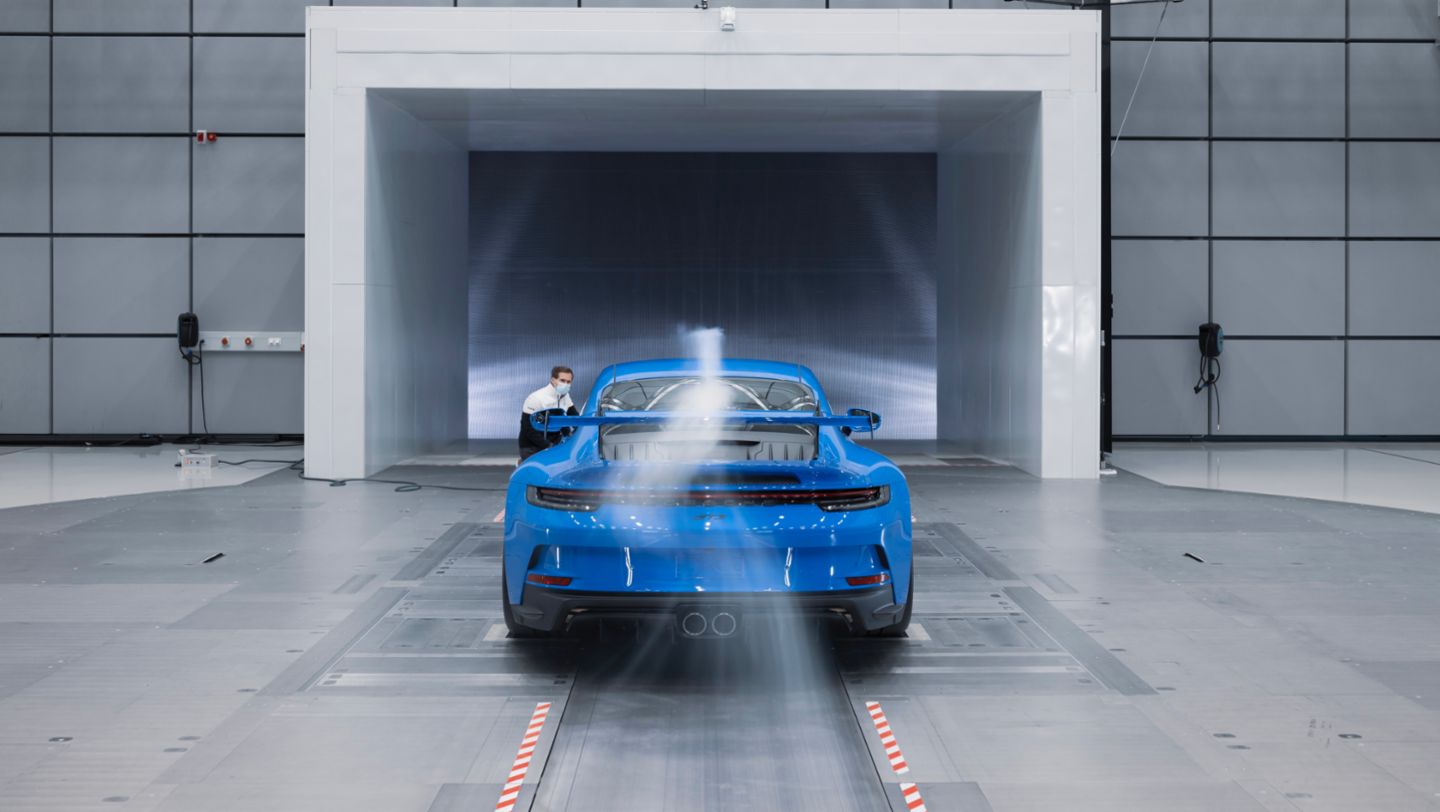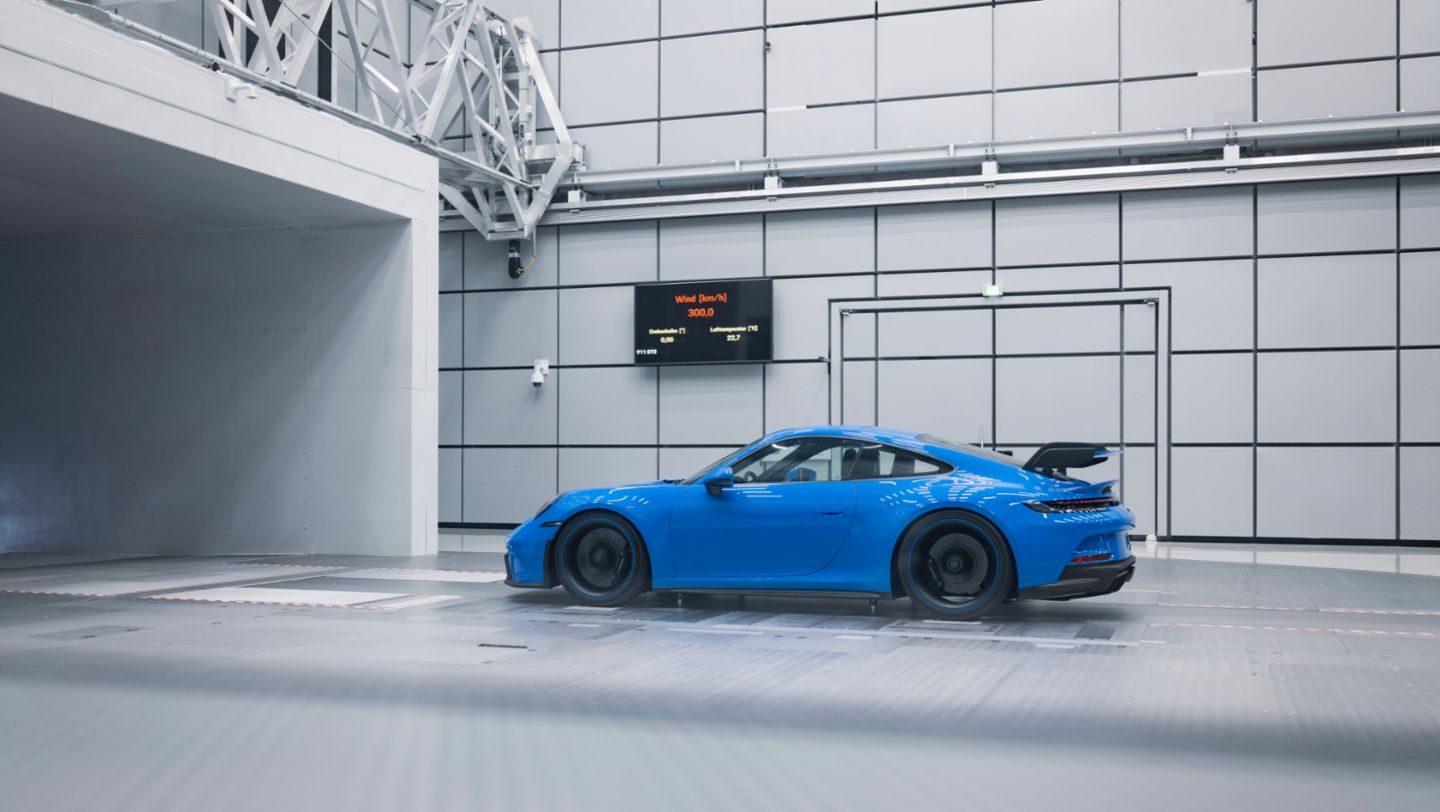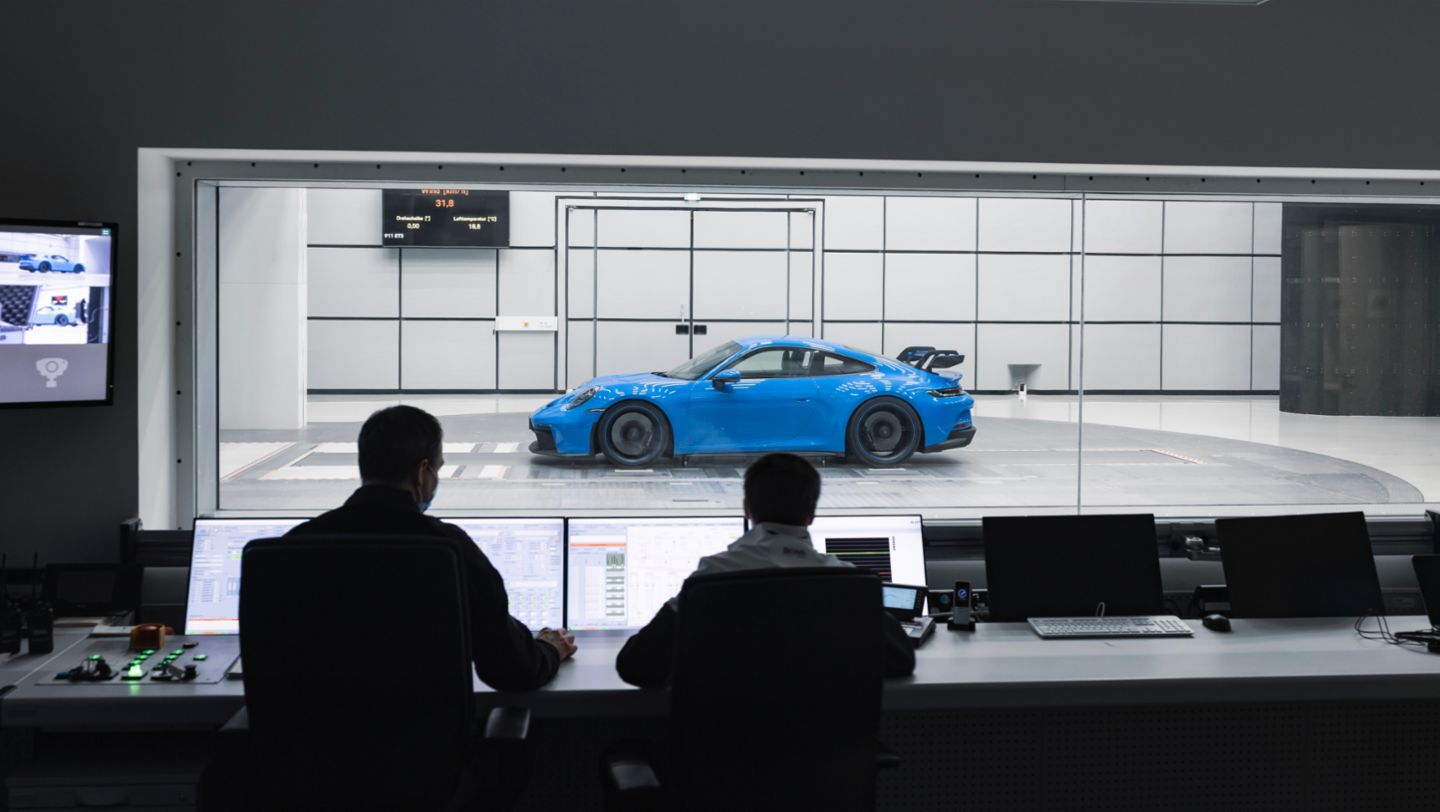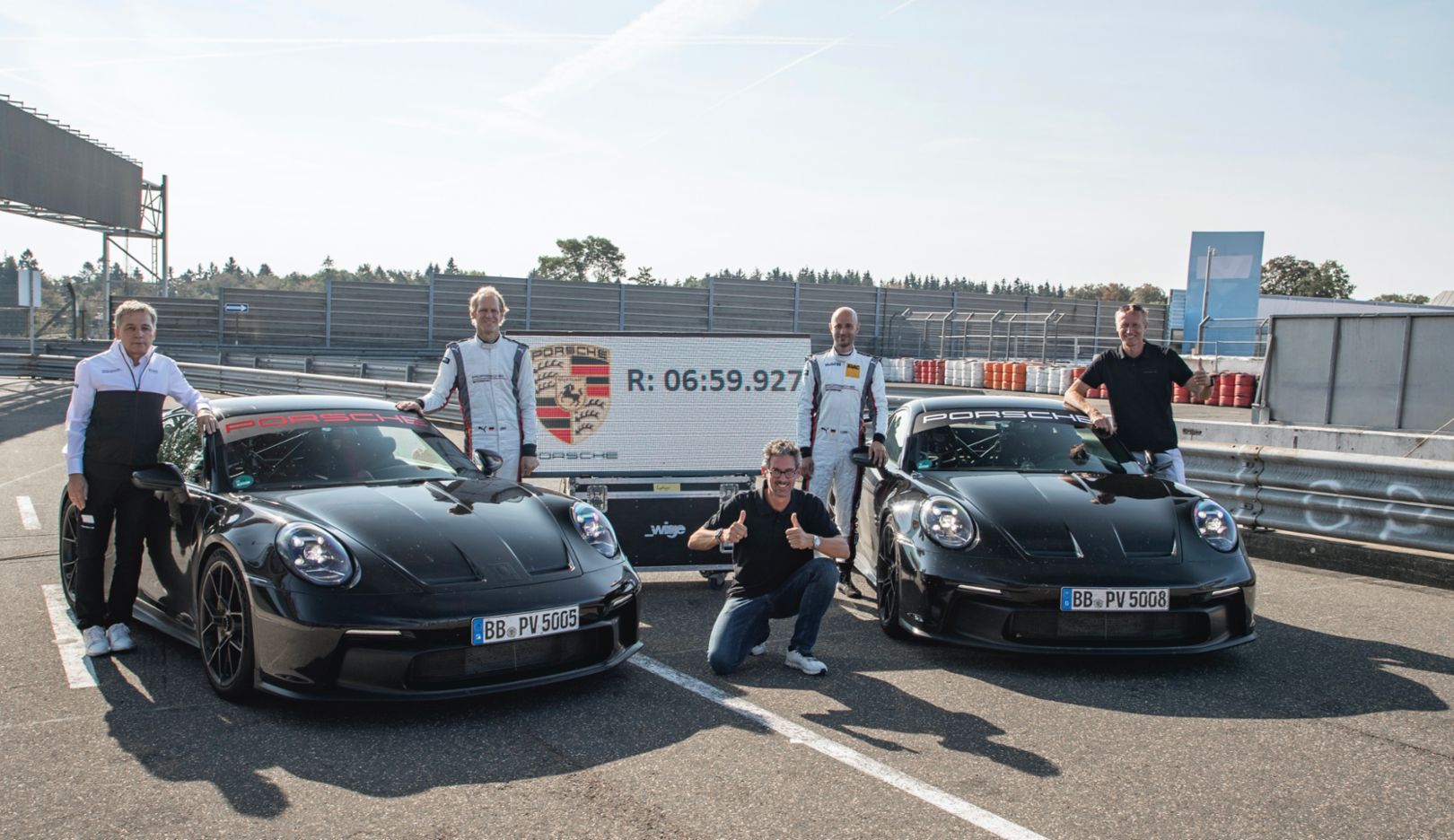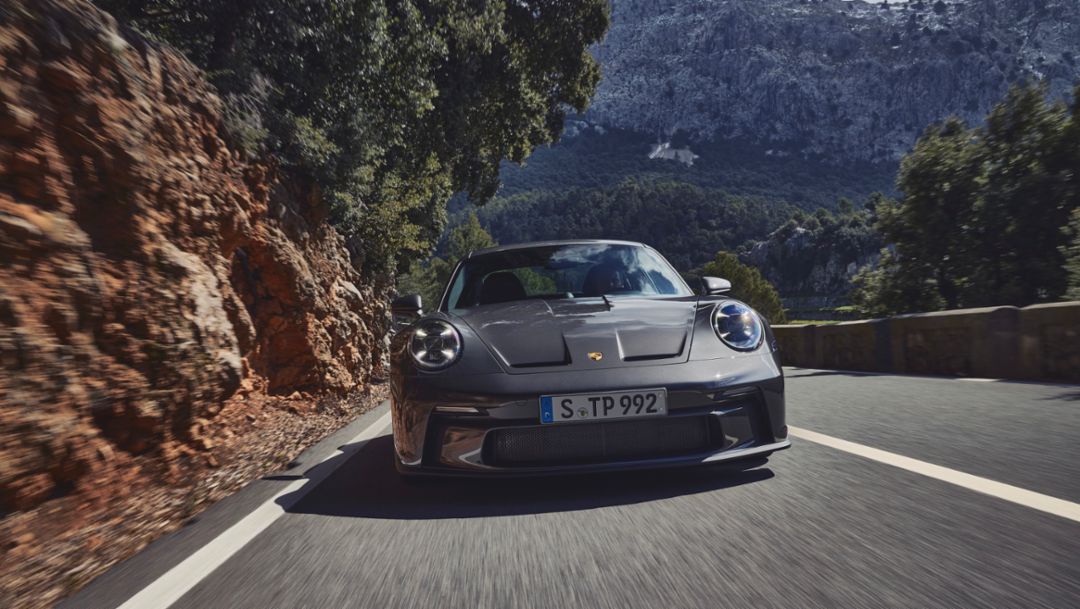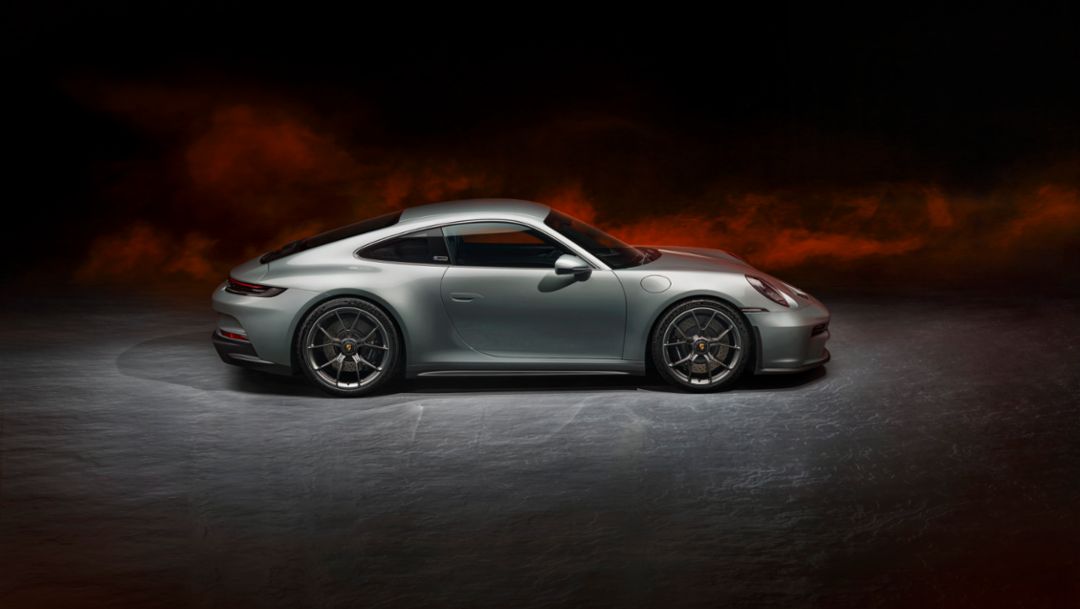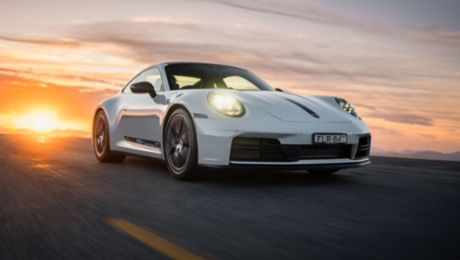Australian model series
The new Porsche 911 GT3 is available in three different model variants:
- Porsche 911 GT3
- Porsche 911 GT3 with Touring Package
- Porsche 911 GT3 70 Years Porsche Australia Edition
The various product details specific to the 911 GT3 with Touring Package and the 911 GT3 70 Years Porsche Australia Edition are provided further down in this article.
Engine: high-revving, naturally aspirated, evocative sound
Powering the new 911 GT3 is Porsche’s famed six-cylinder boxer engine. It’s based on the racing powerplant of the 911 GT3 R and its peak outputs are:
- Maximum power: 375 kW / 510 PS* at 8,400 RPM (10 PS* higher than the previous 911 GT3)
- Peak torque: 460 Nm at 6,100 RPM (10 Nm higher than the previous 911 GT3)
- Maximum engine speed: 9,000 RPM (rev-limited)
The engine’s race-tuned intake system features individual throttle valves (one for each engine cylinder) at the end of a variable intake manifold that uses two switchable resonance valves. This means the air flow into the engine is rapid and precise at all engine speeds.
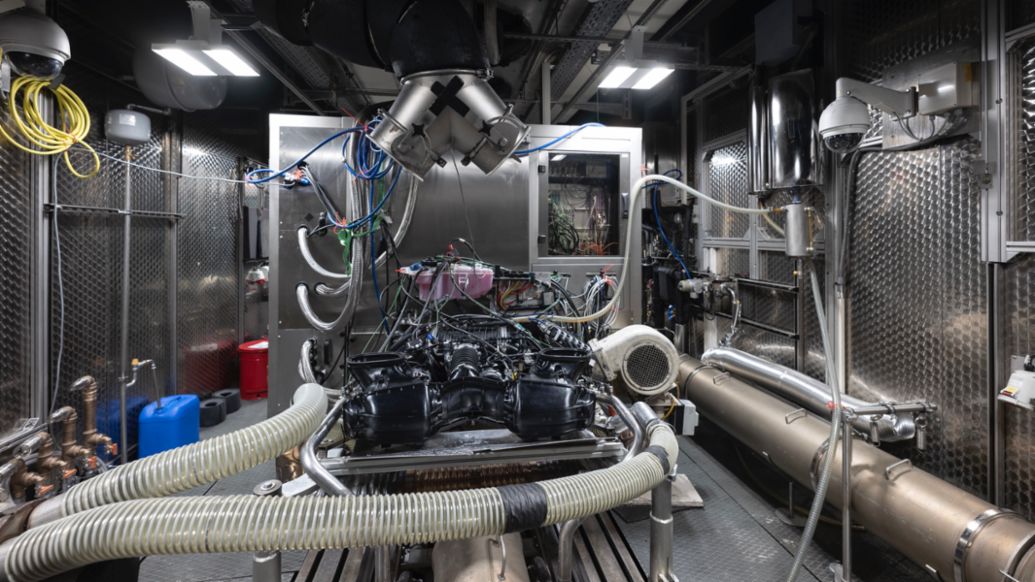
Porsche’s proven VarioCam technology controls camshaft timing precisely according to engine speed and load conditions.
Rigid rocker arms precisely control the cylinder head valves, even at high engine speeds. The valves have factory-set clearances for optimised combustion and reduced maintenance.
Engine friction losses are reduced with large-diameter bearings on the crankshaft, wide connecting rod bearings, and plasma-coated cylinder linings.
Motorsport-derived dry sump oil lubrication with a separate oil tank provide accurate oil control during high-speed cornering, braking and acceleration.
The stainless steel sports exhaust system aids engine response and delivers Porsche’s unmistakable sound, which can be adjusted with an electronically controlled exhaust flap. This light-weight performance exhaust system weighs 10 kilograms less in the new 911 GT3.
Transmission: manual or PDK
Customers have two transmission choices with the new 911 GT3:
- 7-speed PDK (Porsche Doppelkupplung, German for ‘double coupling’) twin-clutch gearbox
- 6-speed GT sports manual transmission
The 911 GT3’s motorsport-developed PDK uses seven forward gears instead of the usual eight, as in the current-model 911 Carrera. Omitting the eighth-speed overdrive gearset reduces the transmission’s weight and underlines the 911 GT3’s performance focus.
The PDK transmission delivers many advantages, including millisecond-fast gear changes for uninterrupted acceleration, and the intelligent automatic mode reduces fuel use and makes driving convenient.
The PDK transmission is fitted with steering wheel-mounted gear-change paddles as well as a conventional gated lever shift for manual gear-changing: pull to shift up and push to shift down, just like in motorsport.
The six-speed manual transmission offers a purist and more involved driving experience. This gearbox weighs 17 kilograms less compared to the seven-speed PDK unit.
The manual shifter has a precise short-travel shift action.
When changing down, an auto-blip function can be used to help match engine and gear speeds, replicating the heel-and-toe method used in motor racing. This avoids over-braking the rear wheels, stabilises handling and reduces wear.
Controlling drive torque between the rear wheels is a rear differential lock. An electronically controlled locking unit is used in conjunction with the seven-speed PDK transmission. A mechanical lock is used with the six-speed manual gearbox.
Suspension and steering: motorsport-derived performance
The new 911 GT3 draws heavily on Porsche’s motorsport experience.
Front suspension:
The front suspension is a highly developed double-wishbone design from formula racing cars. It was used on the 2017 Porsche 911 RSR Le Mans class winner and on the legendary Porsche RS Spyder LMP2 prototype in 2005. This is the first time it’s been used on a Porsche road car.
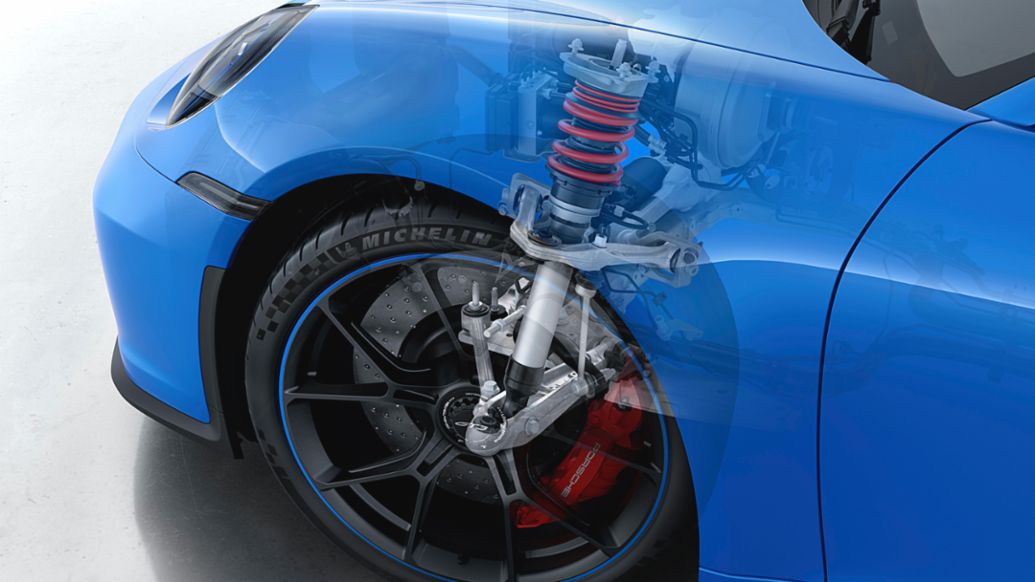
This new double-wishbone design gives numerous advantages:
- It delivers higher camber stiffness under high compression, which means the outside wheel has more support in a high-speed bend.
- The design counteracts braking dive when under hard braking, which means the car remains more stable.
- The spring struts are mounted with a slight angle towards the rear of the car, which means they can also manage rearward forces, and not just forces from an upward direction.
- The double wishbones also remove lateral (sideways) forces from the shock absorbers during cornering, which means they can operate with less disturbance and reduce friction losses.
Overall, the front suspension delivers precise turn-in agility, higher cornering performance and greater braking stability.
Rear suspension:
The rear suspension is a five-link design that securely locates the rear axle with additional ball joints on the lower wishbones.
These additional ball joints are used in place of rubber components due to the elevated stress these parts experience during high-speed cornering. These extra ball joints are practically play-free, which means a direct connection between the car and the road.
Drivers can find the ideal track-driving set-up with adjustable camber and anti-roll bar stiffness, which can be set on the front and rear.
Both the front and rear axles use stiffer springs that are supported by helper springs. These helper springs extend the spring travel to help ensure the tyres remain in contact with the road when the car gets elevated over, for example, a crest in the road. The same system is used in Porsche’s racing cars.The 911 GT3’s shock absorbers are a special design. Their valving offers a wide spectrum of performance between soft characteristics (for comfort) and hard characteristics (for high-performance driving).
Rear-axle steering:
Up to approximately 50 km/h, when the driver turns the steering wheel the rear wheels of the new 911 GT3 turn by a maximum of 2.0 degrees in the opposite direction of the front wheels. This has the effect of shorting the wheelbase up to 6 millimetres, which enhances the 911 GT3’s turn-in behaviour and maneuverability.
At speeds above 80 km/h, the rear wheels steer in the same direction as the front wheels, also by up to 2.0 degrees. This has the effect of lengthening the wheelbase by 6 millimetres, increasing cornering stability.
Between 50 km/h and 80 km/h the rear-axle steering responds according to the driving situation.
Front axle lift system:
The new 911 GT3 is fitted with a front axle lift system (which was also fitted to its predecessor). This button-operated hydraulic system can lift the front of the car by approximately 40 millimetres to clear obstacles such as speed humps.
The intelligent Smart Lift memory is a new function: it stores the position of an obstacle and automatically lifts the car at this location when it’s encountered in the future.
Active chassis systems:
The sports-tuned Porsche Stability Management (PSM) system allows greater driving freedoms before intervening to provide assistance. For racetrack driving, it can be switched fully off (ESC + TC OFF) or with the exception of traction control (ESC OFF).
The Porsche Active Suspension Management (PASM) system has been specifically configured on the new 911 GT3. It lowers the car by 20 millimetres compared to the 911 Carrera.Drivers can select from two control maps: Sport (offers suspension comfort for long-distance driving) and Track (which reduces body movements to a firmer level).
High-performance braking system:
The new 911 GT3 uses larger-diameter (408 millimetres, up from 380 millimetres) internally vented grey-iron brake discs at the front with six-piston Aluminium monobloc fixed brake calipers. The new, larger front discs now use dimples with cone-shaped openings instead of cross-drilling to aid brake-dust extraction, resulting in higher material strength and more powerful braking.
Two separate air ducts provide cooling for the front brakes: one for internal brake cooling and one for the discs.
The rear brake discs are 380 millimetres in diameter (unchanged from the previous model) and use four-piston Aluminium monobloc fixed brake calipers.
The brake calipers on the new 911 GT3 and 911 GT3 with Touring Package are red in colour.
The Porsche Ceramic Composite Brake (PCCB) is optionally available. Boasting higher thermal load capability, the brake discs are 410 millimetres at the front and 390 millimetres at the rear and give a weight-saving advantage of around 50 percent. The brake calipers with the PCCB system are yellow in colour.
Wheels and tyres:
The new 911 GT3 uses different-size wheel diameters between the front and rear axles for the first time:
- Front wheels: 20 x 9.5 inches (up from 9.0 inches)
- Rear wheels: 21 x 12 inches
The wheels are made from a forged light alloy and are now 0.8 kilograms lighter in weight, achieved party by the use of a motorsport-derived centre-lock wheel nut (instead of the usual five separate wheel nuts).
High-performance tyres are fitted, which are 10 millimetres wider (front and rear) compared to the previous model:
- Front: 255/35 ZR 20
- Rear: 315/30 ZR 21
Body and aerodynamics: muscular body, streamlined performance
The new 911 GT3’s fast styling is highly functional.
The front-end routes cool air to the front brakes and radiators and aids aerodynamic downforce on the front axle. This air is then vented through the newly designed, two-part vent in the lightweight carbon fibre bonnet.
The new 911 GT3’s fully clad underbody gets a more constant flow of air thanks to the front diffusers with a wider spoiler lip. At higher speeds, the fully functional rear diffuser accelerates the exiting air to suck this high-performance sports car more effectively to the road.
The new rear wing uses a swan-neck mounting, similar to that used in the 911 GT Endurance racing car and the Le Mans class-winning 911 RSR. Two Aluminium brackets hold the wing element from above, allowing air to flow along its underside to reduce flow losses and improve downforce.
In its factory setting, the level of downforce is 50 percent higher compared to the previous model.
In its performance setting (for the racetrack), the downforce is increased by 150 percent at 200 km/h.
The new rear wing’s angle of attack has four adjustment levels and other aerodynamic elements, such as the air curtains on the front diffuser, can also be adjusted to achieve the desired grip level on a race track.
Porsche’s engineers focused on weight-saving with the new 911 GT3. Some weight-saving examples include:
- Light-weight bonnet made form carbon fibre reinforced plastic (CFRP)
- Light-weight glass for all windows
- Light-weight sports exhaust system
- New rear compartment cover behind the rear seats
- PDK transmission without an 8th-speed gearset
- A 60 Ah LiFePO4 starter battery (more than 10 kilograms lighter than the previous 911 GT3)
Overall, the new 911 GT3 has a power-to-weight ratio of 3.8 kg per kW (with a manual transmission), resembling that of a pure racing car.
Interior: sports-oriented cockpit
The interior of the new 911 GT3 focuses on the driver and their direct surroundings.
The standard Sports Seats Plus have four-way electric adjustment and are trimmed in black leather.
Lightweight full bucket seats from the Porsche 918 Spyder are optionally available on the 911 GT3 and 911 GT3 with Touring Package (they’re fitted as standard to the 911 GT3 70 Years Porsche Australia edition). Made from carbon fibre reinforced plastic (CFRP), these seats have been designed for use with multi-point racing harness belts and weigh 12 kilograms less than the standard Sports Seats Plus.
The three-spoke multifunction steering wheel can be adjusted for both height (up-down) and reach (in-out) to achieve an optimum driving position. The driving mode switch (with three selectable driving modes: Normal, Sport, Track) has been integrated into the steering wheel, a first for the 911 GT3.
The driver’s instrument display uses the classic Porsche 911 format of five dials with a large central analogue engine rev counter.
Next to the rev counter is a shift assistant, a graded series of coloured lights which indicate the optimum moment for changing gears – similar to that used in modern racing cars.
The new Track Screen is unique to the new 911 GT3 and reduces the information displayed to racetrack-relevant data, such as coolant temperature, oil pressure and oil temperature. The tyre pressure monitoring system can distinguish between cold and warm tyres.
A Chrono package that combines an analogue stopwatch on the dashboard with a digital stopwatch in the instrument cluster is also available (standard fitment on the 911 GT3 70 Years Porsche Australia Edition). This package also includes preparation for a lap trigger, which is available through Porsche Tequipment (Porsche’s genuine accessories division). The lap trigger automatically records precise racetrack lap times which can be analysed and compared on the Porsche Track Precision App via a smartphone or laptop. The new 911 GT3 comes pre-wired for the lap trigger when the optional Chrono package is specified at purchase.
The new 911 GT3 is available with a number of personalisation options are available from Porsche Exclusive Manufaktur, such as an Extended interior Leather Package on the 911 GT3 with Touring Package.
Optional Clubsport package
Because a high proportion of Porsche GT models are driven on race tracks, the new 911 GT3 is available with an optional Club Sport Package. This comprises:
- A bolted-in roll bar behind the front seats
- Six-point harness belts on the driver’s side
- Preparation for a battery disconnect switch
- Motorsport-specification hand-held fire extinguisher
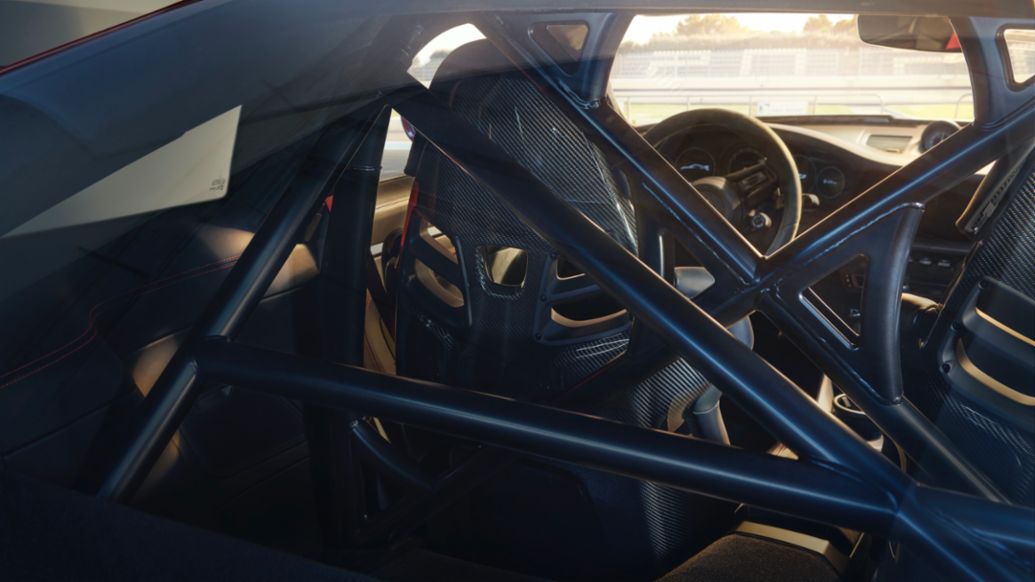
Exhilarating driving performance
The new 911 GT3’s combination of upgraded running gear, aerodynamic grip, increased engine outputs and lower power-to-weight ratio result in a new level of dynamic driving performance:
- 0 – 100 km/h in 3.4 seconds (PDK transmission)
- 0 – 200 km/h in 10.8 seconds (PDK transmission)
- Top speed: 320 km/h (manual transmission; 318 km/h PDK transmission)
The new Porsche 911 GT3 set an official lap time of 6:59.927 minutes on the complete Nurburgring Nordschleife circuit. This time is 17.5 seconds faster than its predecessor and narrowly faster than the 911 GT3 RS.
The 911 GT3 With Touring Package
The new 911 GT3 with Touring Package delivers the 911 GT3’s high-performance athleticism in a more understated package.
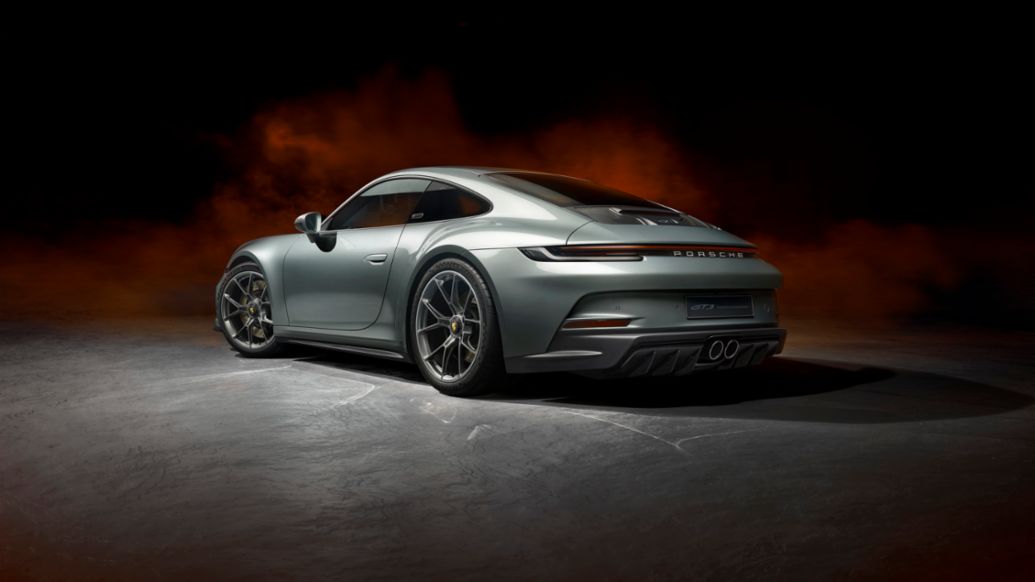
It’s two most notable features are:
- The 6-speed GT sports manual transmission is fitted as standard equipment (7-speed PDK is a no-cost option)
- The external rear wing is replaced by an automatically extending rear spoiler
Externally, the new 911 GT3 with Touring Package includes these details and features:
- Aluminium anodised side window trims
- Side skirts in Black
- Body-coloured front apron (not Black in colour)
- A rear engine-lid grille with the logo ‘GT3 touring’
- Metallic paint finish
Tailpipe trims in a Black finish are a no-cost option, as is the Touring exterior package, which also finishes both the window trims and side skirts in Black.
The interior details specific to the new 911 GT3 with Touring Package are:
- Black interior roof lining with matching A-/B-/C-pillar trims
- Seats upholstered in Black leather with the seat centres in partial Black fabric
- Porsche crest embossed on the seat headrests
- Seat back-shells painted in Silver
- Door release levers in Black with interior trim strips in a mix of Black and brushed Aluminium
- Brushed Aluminium door sill guards in Black with ‘GT3’ logo
The Extended Package Leather interior is also available, which upholsters a variety of interior items in high-quality leather.
The equipment highlights in the new 911 GT3 with Touring Package include:
- LED main headlights including the Porsche Dynamic Lighting System (PDLS); the main headlights in a black finish are a no-cost option
- Automatically dimming mirrors including rain sensor for the wipers
- Lifting system for the front axle
- ParkAssist (rear)
- Rear-view camera
- Digital radio
- Tyre sealing compound with electric air compressor
The name ‘Touring Package’ was first used by Porsche on the 911 Carrera RS from the 1973 model year. Porsche revived it in 2017 with the previous-generation 911 series (Type 991) and it quickly appealed to lovers of top-class sports cars who want understatement and classic driving pleasure.
911 GT3 70 Years Porsche Australia Edition: exclusive limited-edition model
Porsche unveiled this special edition of the new 911 GT3 to celebrate its 70th year in Australia.
This is the first time Porsche has created a market-specific edition of a 911 GT. It’s also the first time Porsche has created a special edition for the Australian market.

The 911 GT3 70 Years Porsche Australia Edition is based on the new 911 GT3 with Touring Package. It was designed in collaboration with experts from the Style Porsche design team, the Porsche Exclusive Manufaktur customisation department and Porsche Cars Australia.
A variety of features distinguish this special car.
Exterior and interior:
- Custom paint finish “Fish Silver Grey Metallic”, a modern interpretation of “Fish Silver Grey”, the colour of one of the first two Porsche 356 imported into Australia in 1951
- Wheels painted in Darksilver with wheel-rim borders in Fish Silver Metallic
- Commemorative badge ’70 Years Porsche Australia Edition’ on each B-pillar
- Full bucket seats in Graphite Blue leather with seat inlays in Graphite Blue and Crayon Madraskaro check fabric
- Dashboard trim painted in Fish Silver Grey Metallic with 'GT3 70 Years Porsche Australia Edition' lettering in Black
- Centre console trim painted in Fish Silver Grey Metallic
- Storage compartment lid with embossing of logo '70'
- Gear shift pattern on gear lever in Crayon
- Door sill guards in brushed Aluminium in Black with 'GT3' (illuminated) and '70 Years Porsche Australia Edition' lettering
- GT3 multi-function sports steering wheel with 12-o’clock marker in Crayon
- Vehicle keys painted in Fish Silver Grey Metallic
- Key pouch in leather in Black and Graphite Blue with stitching in Crayon
- Indoor car-cover in Graphite Blue with piping in Crayon and 'GT3 70 Years Porsche Australia Edition' lettering on the sides in Crayon as well as the 'Porsche Exclusive Manufaktur' logo on the front, also in Crayon
By the numbers
- 375 kW / 510 PS* at 8,400 RPM (10 PS* higher than the previous 911 GT3)
- 460 Nm at 6,100 RPM (10 Nm higher than the previous 911 GT3)
- 3,996cc flat 6-cylinder petrol engine, naturally aspirated
- 7-speed Porsche Doppelkupplung (PDK), rear-wheel drive (6-speed GT sports manual transmission also available)
- Top speed 318 km/h (PDK; 320 km/h with manual transmission)
- 0 – 100 km/h in 3.4 seconds (3.9 seconds with manual transmission)
- 3 model variants available (911 GT3, 911 GT3 with Touring Package, 911 GT3 70 Years Porsche Australia Edition)
- Exhaust system: 10 kilograms lighter
- Brakes: front discs 28 millimetres larger (408 millimetres in diameter, up from 380 millimetres)
- Wheels: 0.5 inches wider at the front
- Wheels: 0.8 kilograms lighter
- Tyres: 10 millimetres wider (front and rear)
- 50 percent more downforce from the newly designed ‘swan-neck’ rear wing, which has 4 manual adjustment settings
- 60 Ah LiFePO4 starter battery (more than 10 kilograms lighter than in the previous model)
- 3.8 kg per kW: power-to-weight ratio (with manual transmission)
- 6:59.927 minutes: The new 911 GT3’s official lap time on the complete Nurburgring Nordschleife circuit; 17.5 seconds faster than its predecessor.
In summary: Porsche has transferred its racing technology into the new 911 GT3, making it perfect for the circuit and superb for everyday use.
Driving comfort and dynamics
- Porsche Active Suspension Management (PASM) with sports set-up and 20-millimetres-lower ride height (compared to 911 Carrera)
- Porsche Stability Management (PSM) including ABS braking, can be gradually disengaged in two stages (ESC OFF and ESC + TC OFF)
- Suspension adjustable for racing use (toe angle, camber, anti-roll bars)
- Speed-sensitive electro-mechanical power-assisted steering with variable ratio
- Rear axle steering with sports setup
- Rear-axle differential lock (electronic control with PDK transmission, mechanical control with manual transmission)
- Newly designed rear spoiler with ‘swan-neck’ mount (retractable rear spoiler fitted to the 911 GT3 with Touring Package and 911 GT3 70 Years Porsche Australia Edition)
- Adjustable suspension for racetrack use
Audio and Communication
- Porsche Communication Management (PCM) including navigation, mobile phone preparation, audio interface and voice control
- Smartphone integration
- Porsche Connect with Apple® CarPlay (wireless) and Android Auto (wired)
- Porsche Track Precision App
Australian standard specifications
- LED main headlights with Porsche Dynamic Lighting System (PDLS) (tinted for 911 GT3)
- Hydraulic lifting system for the front axle (for improved ground clearance)
- Automatically dimming interior and exterior mirrors with integrated rain sensor for wipers
- ParkAssist (rear) with reversing camera
- Digital Radio (DAB+)
- Tyre sealant and air compressor
- Metallic paint
Warranty and Service Pricing
- 3-year / unlimited kilometre warranty
- 1-year / 20,000 kilometre service intervals
- Service pricing varies from state to state due to different labour rates. For an indication of service pricing please visit the website of your nearest Porsche Centre.
What the press say
"Excellence can look a lot like perfection. You only have to look at launch reviews of the Porsche 911 GT3 as a case in point." Andy Enright, MOTOR Performance Car of the Year 2022
"Excellence can look a lot like perfection. You only have to look at launch reviews of the Porsche 911 GT3 as a case in point. Each generation, whether it’s the 996 generation of 1999, the 997 of ’06, or the 991 of ’13, established itself as the best driver’s car in its class."
Andy Enright, MOTOR Performance Car of the Year 2022 (Full review here)
"A lot of cars claim motorsport roots but the 911 GT3 remains the benchmark link between road and track, delivering thrills few cars can match. It really is properly special to drive, delivering an intoxicating combination of speed, precision, and dynamism that translates to a near-peerless driving experience."
David McCowen, news.com.au (Full review here)
The 2021 Porsche 911 GT3 gives you exactly what it says on the box – as the most track-focussed model available in Porsche showrooms, it is sharp, fast and fun.
Porsche never goes backwards and the latest GT3 is an obvious improvement over its predecessor in lots of ways. The most obvious is the added security of the double-wishbone front-end, which also makes the car more enjoyable and less threatening to drive at any speed.
Paul Gover, Carsales.com.au (Full review here)
It’s like an exquisite piece of beautifully crafted furniture or clothing that also happens to double as a seriously hardcore race car that never quits, no matter how challenging the course. As a track weapon, it’s outstanding.
Nathan Ponchard, ChasingCars.com.au (Full review here; video review here)
Put your foot down, and you’ll find it to be a totally terrifying ride, in the best way possible. Naturally, it’s fast, but it’s also unbelievably nimble. Out of corners, it’s forgiving and really gets power down quickly. Sticky and purposeful, it’s like an apex predator (with the ‘Shark Blue’ of the car I drove really reinforcing that characterisation).
Luc Wiesman, D’Marge (Full review here)
Info
More information for consumers: here.
More information for media: here or contact press@porsche.com.au
*PS (Pferdestärke, German for horsepower) is the standard unit used in the European Union to measure the power output of a motor in ‘metric horsepower’
** The published consumption (l/100km and Wh/km), emissions (g/km) and kilometre (km) range figures are determined by Porsche AG testing in accordance with ADR 81/02 on test vehicles. Actual figures will vary as they are dependent on many factors, including without limitation: individual driving style, road and traffic conditions, environmental conditions, fuel quality, a vehicle’s or battery’s condition, load and use. Extra features and accessories (eg: equipment, wheels or tyres used etc.) can change relevant vehicle parameters such as weight, rolling resistance and aerodynamics and can also affect the consumption, emission, range and performance values of a vehicle. CO₂ emissions can also be generated at the power source when vehicles are being recharged, unless 100% renewable energy is used. Generally, consumption, emissions, kilometre range and charging times will vary from the published figures in real world Australian driving and charging conditions.
Apple App Store is a registered trademark of Apple Inc.
